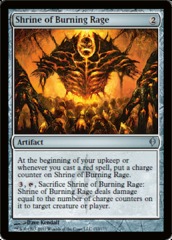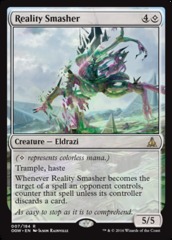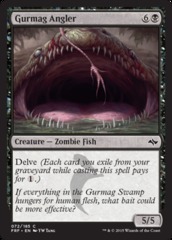Shrine on, you crazy diamond

I’m going to start this off by admitting that my Grand Prix Birmingham did not go the way I had hoped. Armed with the modern deck I’m most practiced with, I waded in with a playset of Lava Spikes and a single Stomping Ground.
They did not serve me well.
I started off the day with a single bye and climbed quickly to 4-1. Feeling confident, I strode into battle against my first (and only) Eldrazi Tron opponent of the tournament, and was quickly dismantled by Thought-Knot Seers and Chalice of the Void. With my confidence broken and running a little below average, I closed the day off at 5-4, narrowly missing day two against a slew of Collective Brutalities out of Grixis Control, a deck that had been a runaway matchup for Burn only a year ago.
I came away from the event feeling that Burn’s time at the top tables was over, and that as long as black decks populated the Modern metagame, I would have to leave my Rift Bolts to gather dust on some long forgotten shelf. How wrong I was!

| Burn | |
| Loïc Le Briand | 1st Place, Grand Prix Birmingham |
| Main Deck (60) | |
| Creatures (8): | Lands (20): |
| 4 Goblin Guide | 4 Arid Mesa |
| 4 Monastery Swiftspear | 3 Bloodstained Mire |
| 3 Inspiring Vantage | |
| Spells (28): | 3 Mountain |
| 4 Lava Spike | 2 Sacred Foundry |
| 4 Lighting Bolt | 1 Stomping Ground |
| 4 Boros Charm | 4 Wooded Foothills |
| 4 Lightning Helix | |
| 4 Searing Blaze | Sideboard (15) |
| 4 Skullcrack | 2 Grim Lavamancer |
| 4 Rift Bolt | 2 Path to Exile |
| 3 Relic of Progenitus | |
| Artifacts (4): | 2 Shattering Spree |
| 4 Shine of Burning Rage | 4 Destructive Revelry |
| 2 Kor Firewalker |
This deck comes far out of left field with a four-of from my glory days starting Magic – Shrine of Burning Rage. The powerful artifact has worked its way to a Grand Prix title after five years of no play whatsoever, and Loïc Le Briand has eschewed Burn all-star Eidolon of the Great Revel in its favour. So why has stock gone down on the enchantment creature? Simple:



With a number of the modern decks of the current era going “bigger”, even if ahead of schedule, Eidolon is triggering much less now than ever, and two toughness creatures have a huge target on their head against Collective Brutality which it enable easy two-and-a-half for ones. There are fewer control decks in the format which spin wheels with Snapcaster Mage/Serum Visions than in formats of old, and of the more popular decks only Grixis Death’s Shadow adopts this play pattern. Grixis avoids this weakness through Fatal Push, Collective Brutality and huge threats providing a quick clock, turning the triggered ability against you.
With removal spells running rampant around Modern, moving to Shrine of Burning Rage is a natural step. Leaving your opponent with more dead draws can buy you extra turns by increasing the number of bricks in the midgame. Crucially, an early Shrine is a powerhouse against Death’s Shadow decks. With only one or two ways to destroy it, Shrine will put the opponent on a fast clock, ticking up with each burn spell regardless of whether it resolves. This pressure will force an opponent to develop a clock to fight back which most often involves aggressively reducing their life totals to power out a Death’s Shadow, which plays right into Shrine’s huge damage output.
At only two mana, Shrine will often sneak in underneath Stubborn Denial before a 4+ power creature hits the board, and a couple turns before a Chalice of the Void. In addition, against both of these you still get more bang for your buck with a Shrine or two in play, letting you invest in damage down the line regardless of whether your spell resolves. Giving some power back to one-cost cards against Eldrazi Tron has a lot of value when it would otherwise turn off most of your deck, and they have to reach for the sluggish Ratchet Bomb to answer you.

Shrine does impose a high costs on the user however, as any deck starring Abrupt Decay will usually be able to cleanly answer the powerful artifact, or else demand the user leaves up three mana at all times – far too great a tempo loss to stomach. In a more general case, this deck offers higher resiliency and an abstractly more powerful late game than a traditional Burn deck, but suffers reduced consistency and speed. There are many games won by Burn with the pilot at two or fewer lands, and having four cards blanked by this scenario will likely lead you to have to mulligan more conservatively to hit your third. In addition, a topdecked Shrine in the midgame will often be either blank, or otherwise demand a five mana investment over multiple turns for a two damage return; you don’t really want to find these anywhere other than your opener.
Some interesting decisions in the sideboard paid Le Briand dividends over the weekend, and I would expect may become commonplace amongst Burn players going forwards. Alongside a full four Destructive Revelry, Le Briand played two Shattering Spree – while not entirely necessary for the Affinity matchup, this card really shines against Eldrazi Tron, the Replicate trigger allowing you to circumnavigate any number of Chalice of the Void given enough mana, and giving more live draws to answer the devastating Basilisk Collar. Also noteworthy is the lack of Deflecting Palm, which until now had been a staple sideboard two-of in the archetype. Palm has been something of a victim of its own success, and all the threats that it once preyed on now find themselves in archetypes with ways to play around it. Death’s Shadow decks play a slew of discard and Stubborn Denials, giving your opponent the option to remove it as a threat entirely or otherwise play around it until they can leave up Denial in combat. Eldrazi Tron players will seldom walk into it with a Reality Smasher when Thought-Knot Seer can either strip it out or give them ample warning that it’s coming, giving time to set up a Chalice on two or chip away with Walking Ballista plus Collar.
While I don’t know about the staying power of this deck over the life of the format, with WotC likely not to pull the trigger on any more Modern bans in the near future this new take on an old classic is a great way to attack the current format.





